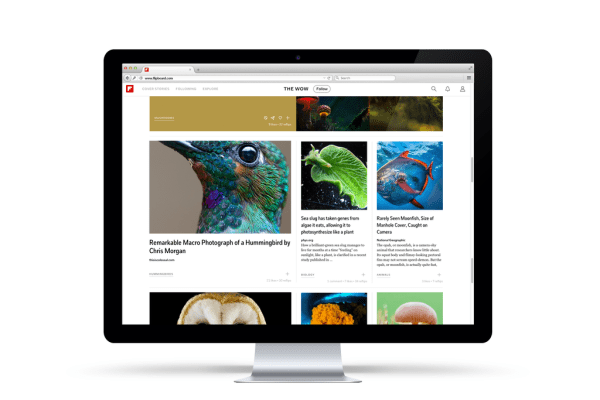It’s taken several years, but Flipboard is finally coming to the platform where most digital publishers start. After providing readers with beautiful, personalized mobile magazines on their mobile devices, the company is re-launching its web page to do the same.
Flipboard’s apps enable readers to flip through stories based on different sources and topics they subscribe to. Until today, however, Flipboard was 100 percent mobile, living only on users’ tablets and mobile phones. In part, that’s because web browsers weren’t quite ready when the company first launched.
“When we were originally going to build Flipboard for the web, we realized it was a super hard thing to do,” co-founder Mike McCue told me. Back in 2010, when the company was founded, developing for the newly announced iPad seemed like a better solution than trying to reimagine publishing for the web.
But after nearly five years of focusing on apps for iOS, Android, and Windows devices, the company is finally ready to bring its magic to desktop. In doing so, Flipboard hoped to make its website familiar, but also to build an experience that was true to the web.
In the same way it dynamically re-builds stories for optimal layout on smartphones and tablets, Flipboard’s web version takes advantage of the unique design principles and user interaction features on the desktop. Instead of flipping through different articles on mobile touchscreens, Flipboard’s web design is built to enable users to scroll through content that is relevant to them.
Layouts change based on the type of content that is displayed, with some of them featuring full-bleed images and other highlighting text. At the same time, the web version takes advantage of all the personalization features the company has built over the years.
Readers can subscriber to any of the 34,000 topics available, as well as custom magazines created by others. More than 15 million of those magazines have been created since Flipboard launched them almost two years ago. Just like on mobile, users on the web can create their own magazines, share them on other social networks, like them or save them for later.
Unlike Flipboard apps, the website doesn’t default to re-formatting a story you click through to read — instead, it sends readers directly to a publisher’s page. That said, the company has partnered with a few publishers — like National Geographic — to dynamically format their stories on its site.
There are reasons why Flipboard probably does this. For now, publishers would prefer to have readers come to their sites and monetize them — that is, show ads to them. If you go to NatGeo’s page, however, you’ll see its articles and photo essays in the full glory of what Flipboard can do if it’s given a chance to re-format them.
McCue says the company isn’t looking to become anyone’s home page, but there are some publishers who are already creating magazines around certain topics that get the same treatment. It’s a kind of hack to give readers a new way of viewing a page that doesn’t have the same two- or three-column format as every other website out there.
(It would be awesome if, say, TechCrunch could just outsource its design to Flipboard.)
While Flipboard won’t have a ton of ads on its webpage at launch, as time goes on you can expect that to ramp up. In the same way it’s looking to re-imagine digital magazines on apps and the web, it wants to bring those magazine-like ads to its web site.
After all, its business model depends on it. And hey, since Flipboard has raised more than $160 million since being founded, it’ll need some of that ad revenue to justify its valuation.
